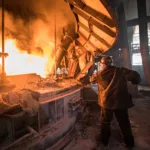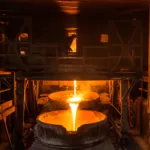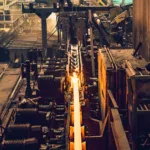Optimizing Quality, Cost, and Furnace Performance
In steel production, scrap is not just a raw material—it’s a key factor in cost control, melt chemistry, energy consumption, and furnace lining durability. The type, quality, and proportion of scrap used directly impact melt quality and operational efficiency. That’s why developing the right scrap mix ratio and applying an effective charging strategy is critical to maximizing performance and minimizing losses.
In this article, we break down how to plan scrap composition based on furnace type, steel grade, and operational targets.
Scrap Types & Key Characteristics
HMS (Heavy Melting Scrap)
-
Thick sections, low contamination
-
Slower to melt but thermally stable
-
Forms the base charge material
DKP (Deep Drawing Press Scrap)
-
Thin, low-carbon steel sheets
-
Melts quickly and enhances energy efficiency
-
Supports faster melt time; must be proportioned carefully
Casting Scrap
-
High carbon content
-
May contain alloying elements like Mn or Cr
-
Risk of cracking during solidification
Chips & Light Scrap
-
Economical and widely available
-
May contain moisture or oil—use with caution
-
Limited use in arc furnaces due to reactivity
Alloyed Scrap (Ni, Cr, Mo-bearing)
-
Used in specialty steel grades
-
Requires close tracking of melt chemistry
How to Determine the Right Scrap Mix
When designing a scrap mix, the following technical factors should be considered:
1. Target Steel Grade
-
Balance carbon, manganese, silicon, sulfur, and phosphorus levels
-
Use alloyed scrap to achieve chemistry targets
-
For low-carbon grades, increase DKP proportion
2. Furnace Type & Capacity
-
Electric Arc Furnace (EAF):
~60–70% HMS, 30–40% DKP/supporting material -
Induction Furnace:
High DKP and clean scrap content preferred -
Basic Oxygen Converter:
High-carbon scrap used in controlled portions
3. Melting Time & Energy Efficiency
-
DKP accelerates melting and improves energy use
-
HMS stabilizes heat input
-
Excessively thin scrap can cause arc instability and heat loss
4. Physical Size & Charging Logistics
-
Large scrap (HMS) at the bottom, smaller pieces (DKP) on top
-
Chips should be briquetted or limited in open charge mixes
5. Chemical Cleanliness & Moisture
-
Contaminants (paint, oil, plastics) can damage refractories and pose explosion risks
-
Moisture content should be under 1%
-
DKP is typically dry and clean—ideal for use after sintering
Sample Scrap Mix – 30-Ton EAF
| Scrap Type | Ratio (%) | Notes |
|---|---|---|
| HMS 1 / HMS 2 | 60% | Primary structural base |
| DKP | 25% | Speeds up melting |
| Casting Scrap | 10% | Carbon balance contribution |
| Chips / Others | 5% | Economic filler, controlled use |
These values should be adapted based on steel grade, furnace design, and production goals.
What Can Go Wrong with a Poor Scrap Mix?
-
Prolonged melt time and higher energy costs
-
Electrode wear due to unstable arc behavior
-
Inconsistent chemical analysis (C, Mn deviation)
-
Refractory cracking and potential metal leaks
-
Slag imbalance and increased metal loss
Alpha Refractory LLC: Your Scrap Strategy Partner
Scrap blending isn’t just an economic decision—it’s an engineering challenge that requires careful planning.
At Alpha Refractory LLC, we support industrial clients with:
-
Scrap classification and analysis
-
Charging strategy optimization
-
Scrap-to-furnace compatibility planning
-
Alloy balancing and cost-performance mapping
-
Field training and implementation support
The right scrap mix equals stable chemistry, faster melts, safer furnaces, and lower cost per ton.
Let Alpha Refractory help you make it happen.




